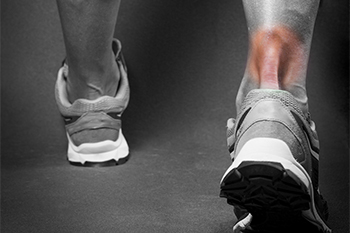What Can Cause Achilles Tendinopathy?
Tuesday, 08 February 2022 00:00 The large tendon located at the back of the ankle, which connects the heel bone to the calf muscle, is known as the Achilles tendon. It is the largest tendon in the body, allows you to stand on tiptoe and bears a lot of stress. Activities such as running, jumping, or standing for a long period of time can cause the Achilles tendon to swell, stiffen and become painful. This condition is known as Achilles tendinopathy. Factors such as older age, being overweight, tightness in the calf muscles, poor limb alignment, and stiff joints in the foot can contribute to Achilles tendinopathy. Because of the severity of an Achilles injury, patients who are struggling with pain or tenderness in this tendon would be wise to visit a podiatrist for an evaluation.
The large tendon located at the back of the ankle, which connects the heel bone to the calf muscle, is known as the Achilles tendon. It is the largest tendon in the body, allows you to stand on tiptoe and bears a lot of stress. Activities such as running, jumping, or standing for a long period of time can cause the Achilles tendon to swell, stiffen and become painful. This condition is known as Achilles tendinopathy. Factors such as older age, being overweight, tightness in the calf muscles, poor limb alignment, and stiff joints in the foot can contribute to Achilles tendinopathy. Because of the severity of an Achilles injury, patients who are struggling with pain or tenderness in this tendon would be wise to visit a podiatrist for an evaluation.
Achilles tendon injuries need immediate attention to avoid future complications. If you have any concerns, contact Dr. Scott Shrem of Garden State Foot & Ankle Center. Our doctor can provide the care you need to keep you pain-free and on your feet.
What Is the Achilles Tendon?
The Achilles tendon is a tendon that connects the lower leg muscles and calf to the heel of the foot. It is the strongest tendon in the human body and is essential for making movement possible. Because this tendon is such an integral part of the body, any injuries to it can create immense difficulties and should immediately be presented to a doctor.
What Are the Symptoms of an Achilles Tendon Injury?
There are various types of injuries that can affect the Achilles tendon. The two most common injuries are Achilles tendinitis and ruptures of the tendon.
Achilles Tendinitis Symptoms
- Inflammation
- Dull to severe pain
- Increased blood flow to the tendon
- Thickening of the tendon
Rupture Symptoms
- Extreme pain and swelling in the foot
- Total immobility
Treatment and Prevention
Achilles tendon injuries are diagnosed by a thorough physical evaluation, which can include an MRI. Treatment involves rest, physical therapy, and in some cases, surgery. However, various preventative measures can be taken to avoid these injuries, such as:
- Thorough stretching of the tendon before and after exercise
- Strengthening exercises like calf raises, squats, leg curls, leg extensions, leg raises, lunges, and leg presses
If you have any questions please feel free to contact our office located in Hazlet, NJ . We offer the newest diagnostic tools and technology to treat your foot and ankle needs.
Blog Archives
- May 2025
- April 2025
- March 2025
- February 2025
- January 2025
- December 2024
- November 2024
- October 2024
- September 2024
- August 2024
- July 2024
- June 2024
- May 2024
- April 2024
- March 2024
- February 2024
- January 2024
- December 2023
- November 2023
- October 2023
- September 2023
- August 2023
- July 2023
- June 2023
- May 2023
- April 2023
- March 2023
- February 2023
- January 2023
- December 2022
- November 2022
- October 2022
- September 2022
- August 2022
- July 2022
- June 2022
- May 2022
- April 2022
- March 2022
- February 2022
- January 2022
- December 2021
- November 2021
- October 2021
- September 2021
- August 2021
- July 2021
- June 2021
- May 2021
- April 2021
- March 2021
- February 2021
- January 2021
- December 2020
- November 2020
- October 2020
- September 2020
- August 2020
- July 2020
- June 2020
- May 2020
- April 2020
- March 2020
- February 2020
- January 2020
- December 2019
- November 2019
- October 2019
- September 2019
- August 2019
- July 2019
- June 2019
- May 2019
- April 2019
- March 2019
- February 2019
- January 2019
- December 2018
- November 2018
- October 2018
- September 2018
- August 2018
- July 2018
- June 2018
- May 2018
- April 2018
- March 2018








